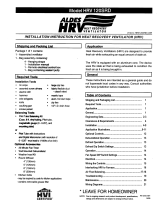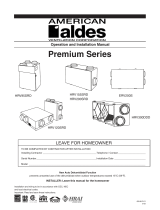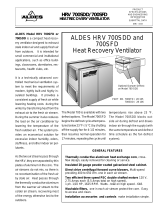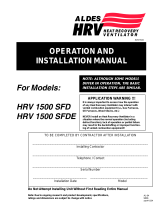Page is loading ...

HRV LHRV L
HRV LHRV L
HRV L
TT
TT
T
-15, L-15, L
-15, L-15, L
-15, L
TT
TT
T
-20-20
-20-20
-20
HEAHEA
HEAHEA
HEA
T RECOVERY VENTILAT RECOVERY VENTILA
T RECOVERY VENTILAT RECOVERY VENTILA
T RECOVERY VENTILA
TT
TT
T
OROR
OROR
OR
PRODUCT
SPECIFICATIONS
AND ENGINEERING
INFORMATION
-----
SUBMITTAL DATA
746-7-00
ALDES HRV LT-15, LT-20
Air to Air Heat Recovery Ventilator
ALDES Model HRV LT-15 and LT-20 are
compact heat recovery ventilators designed to
exhaust stale indoor air and supply fresh air
from outdoors. When operated at full speed,
the LT-15 unit can meet the general ventilation
requirements (0.35 air changes per hour—
ASHRAE 62-1989) of a home up to 2800 sq. ft,
and the LT-20 of a home up to 4000 sq. ft. (On
a smaller home, they can be operated at lower
speed, reserving excess capacity for tempo-
rary increases in humidity or other contami-
nants.) They are technically advanced con-
trolled mechanical ventilation systems designed
to meet the requirements of modern, tightly
built and highly insulated homes. They provide
a consistent supply of fresh air while lowering
heating costs during the winter by transferring
heat from the exhaust air to the fresh air stream.
During the summer they also reduce the load
on the air conditioner by lowering the tempera-
ture of the fresh outdoor air. (For southern
climates, where air conditioning costs are the
major concern, one of the ERV models should
be considered, because of their ability to re-
duce the humidity of the fresh air as well as
lowering the temperature.) The systems pro-
vide an economical solution for excessive in-
door humidity, odors, stuffiness, and other in-
door air pollutants.
As the two air streams pass through the HRV,
they are separated by thin plates of aluminum
in the core. The air streams do not mix, so there
is no recontamination of the fresh air by stale
air. Heat passes through the thermally conduc-
tive aluminum from the warmer air stream to the
colder air stream, recovering most of the en-
ergy otherwise lost to the outdoors.
DUCTING CONSIDERATIONS
Equally important to providing fresh air supply
and exhaust of stale air is the means of assuring
internal distribution of fresh air throughout the
occupied space(s) and exhaust of stale air from
highly polluted areas. The designer/specifier
should select the means of internal distribution
when the ventilation system is planned. Three
popular methods are detailed below, with ad-
vantages and disadvantages for each type.
FULLY DUCTED SYSTEM
Dedicated exhaust and supply ducting to all
spaces that can be closed. Fresh air to bed-
rooms, dens, office spaces, etc. Exhaust air
from zones that produce high levels of pollut-
ants, such as kitchen, bathrooms, laundry, util-
ity rooms with stored household chemicals, etc.
Advantages: Lowest operating costs, relying
only on the small low power blowers of the HRV,
instead of large central air handlers in furnaces
or heat pumps. Improved ventilation efficiency,
as pollutants are exhausted with minimal mix-
ing in the occupied spaces and freshest air is
delivered to zones where occupants spend
large amount of time. Quiet bathroom and
kitchen exhaust as compared to conventional
fans for these areas. Reduced cost of equip-
ment to ventilate these areas. Reduced roof
and wall penetrations for independent fans.
GENERAL FEATURES
Thermally conductive aluminum heat exchange core, cross-flow design, easily
removed for cleaning or service.
Efficient multi-speed motor drives a centrifugal blower in each air stream. Quiet,
high efficiency PSC motor. 120 V., 1.4 Amps
Washable filters on each air stream protect the core. Easy to access and clean.
Automatic defrost system activates when outdoor temperature falls below
25 °F (-4 °C). The defrost cycle is preset at the factory so that after 17 minutes of
outdoor temperature below this set point, the motor driven damper closes the
outdoor air connection, and opens the defrost port to draw warm indoor air across
the core. After 3 minutes of defrost operation, the damper reverses to restore fresh
air supply and close the defrost port. The 17 minute normal ventilation and 3
minute defrost cycle continue until outdoor air temperature rises above
25 °F (-4 °C). During the 3 minute defrost cycle, the HRV operates at high speed.
The cycle times are installer selectable to meet the needs of different climates and
operating conditions.
Casing is heavy gauge pre-painted steel to protect against corrosion, and minimize noise.
Installation accessories and controls make installation simple.
Disadvantages: Higher installed cost for addi-
tional ductwork. Unless bedrooms are provided
with some form of zoned heat, cooler supply air
to bedrooms may result in cooler temperature in
these spaces.
HALF-DUCTED SYSTEM
Similar to fully ducted system, except supply air
delivered to a central location or to the return of
a forced air system.
Advantages: Low installation costs, as ductwork
is reduced. Good tempering of outdoor air when
ducted to the return of the furnace or heat pump.
Good ventilation efficiency, as pollutants are
exhausted with minimal mixing in the occupied
spaces. Quiet bathroom and kitchen exhaust as
compared to conventional fans for these areas.
Reduces cost of equipment to ventilate these
areas. Reduced roof and wall penetrations for
independent fans.
Disadvantages: Higher operating costs when
air handler is required to distribute fresh air.
Greater potential for draft with high air volumes
circulating at room temperature.
FULLY INTEGRATED WITH FORCED AIR
The exhaust air is drawn from the return duct
and fresh air is supplied downstream in the
return duct or in the forced air heating supply
ducting.
Advantages: Lowest installation costs, with mini-
mal ductwork. Thorough mixing of fresh air through-
out dwelling. Good tempering of outdoor air.
Disadvantages: Requires forced air handler to
run continuously with the ventilation system, or
internal short-circuiting of supply and exhaust will
occur in the ducting. Higher electrical operating
costs since air handler is required to distribute
fresh air. Greater potential for draft with high air
volumes circulating at room temperature.
LT-15 PART NO. 28 045
LT-20 PART NO. 28 047

(
4537 NORTHGATE COURT
SARASOTA, FL 34234-2124, USA
Tel: 941 • 351- 3441
Fax: 941 • 351- 3442
www.aldes-us.com
e-mail: [email protected]
RECYCLED PAPER
746HRV-LT-7--00-pm6
BY MATHEWS GRAPHIC DESIGN
PP
PP
P
ROJECTROJECT
ROJECTROJECT
ROJECT
DD
DD
D
AA
AA
A
TETE
TETE
TE
SS
SS
S
UBMITTEDUBMITTED
UBMITTEDUBMITTED
UBMITTED
BB
BB
B
YY
YY
Y
CC
CC
C
ONTRAONTRA
ONTRAONTRA
ONTRA
CTORCTOR
CTORCTOR
CTOR
S P E C I F I C A T I O N S
THERMALLY CONDUCTIVE, PATENTED ALUMINUM CORE: The
cross-flow heat recovery core transfers heat between the two air
streams. It is easily removed for cleaning or service.
MOTORS AND BLOWERS: Each air stream has one centrifugal blower
driven by a common PSC motor. 120 VAC, 1.4 Amps.
FILTERS: Washable air filters in exhaust and supply air streams.
MOUNTING THE HRV: Four 10-24 5/8” threaded inserts at corners of
case designed to accept four PVC reinforced polyester straps that are sup-
plied with the unit.
DEFROST: Damper defrost system; defrosts automatically as the out-
door temperature falls.
CASE: Twenty gauge prepainted galvanized steel (G60) for superior
corrosion resistance. Insulated to prevent exterior condensation. Drain
connections 2 - 1/2” (12 mm) OD.
WEIGHT: 71 lbs. (32.5 kg) SHIPPING WEIGHT 73 lbs. (33.5 kg)
CONTROLS: Basic ON/OFF control is maintained with the 3 foot,
120VAC, 3-prong electrical cord providing power to the HRV.
HRV DEFAULTS TO LOW SPEED when plugged in. HIGH SPEED op-
tion is accessible by connecting remote, low voltage, 2-wire controls (up
to 10) or (up to four 28 884 -20 minute fan timers) to designated terminals
inside electrical box of HRV.
STANDARD SPEED SETTING can be increased by manipulating jump-
ers in electrical box. OFF (Standby) /LOW or OFF/HIGH speed opera-
tion also available by manipulating jumpers.
OFF, LOW and HIGH speeds are all remotely controllable when an op-
tional 28 883 Dehumidistat Ventilation Control (DVC) is connected to the
HRV’s electrical box.
APPROVALS: SAFETY: ETL Tested / Certified to UL 1812
CSA
PERFORMANCE: HVI Tested / Certified to CSA 439-88
P E R F O R M A N C E
HVI CERTIFIED
Net Supply airflow in cfm (L/s) against external static pressure
E .S .P .
LL
LL
L
TT
TT
T
-15 -15
-15 -15
-15
[cfm (L/s) ]
LL
LL
L
TT
TT
T
-20 -20
-20 -20
-20
[cfm (L/s) ]
0.1" (25 Pa) 177 (83) 214 (101)
0.2” (50 Pa) 164 (77) 206 (97)
0.3” (75 Pa) 156 (73) 193 (91)
0.4” (100 Pa) 143 (67) 184 (87)
0.5” (125 Pa) 123 (58) 170 (80)
Max. Sensible Effectiveness 78% 69%
Test Parameters 67 cfm (32 L/s) 127 cfm (60 L/s)
Sensible Effectiveness 76% 67%
Sensible Efficiency
@ 32° F ( 0° C ) 66% 60%
Sensible Efficiency
@ -13° F ( -25° C ) 60% 59%
VAC @ 60HZ 120 120
WATTS / High @ .3" w.c. 173 182
WATTS / High @ .3" w.c. 63 70
OPTIONS
28 884 20 Minute Fan Timer (3 wire)
28 998 Sixty Minute Remote Timer (2 wire)
28 883 Dehumidistat Ventilation Control, Remote
Dehumidistat w/ HRV system on/off switch
28 882 Dehumidistat Control, Remote Wall Mount,
Horizontal Mounting, Low Voltage white)
22 026 Weatherhoods, 6” (150 mm) c/w 1/4’ (6 mm) screen
All units conform to
CSA and UL
Standards
WARRANTY
Units carry a 15
year warranty on
the heat recovery
core and a 2 year
replacement parts
warranty.
CONDENSATE DRAINS
/





